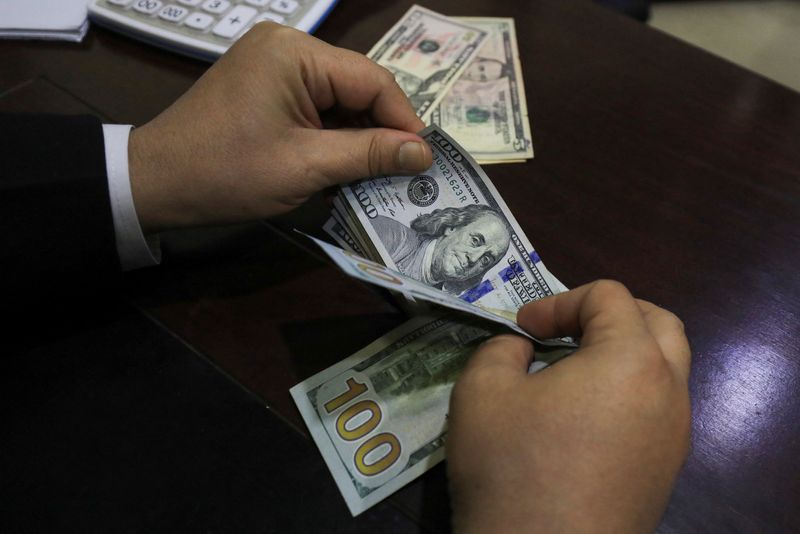Forex
Dollar rises towards highest in over 2 years, euro up, yen falls

By Stefano Rebaudo
(Reuters) -The dollar rose towards its highest level in more than two years on Tuesday as strong economic data led investors to scale back bets on Federal Reserve rate cuts, while potential U.S. tariffs remained in the spotlight.
After a jobs report on Friday reinforced support for the U.S. central bank’s cautious stance, investors will closely watch U.S. inflation readings, with producer prices (PPI) due later on Tuesday and consumer prices (CPI) on Wednesday.
Traders are pricing in 28 basis points of Fed monetary easing this year, less than the 50 basis points the Fed projected in December.
U.S. Treasury 10-year yields touched a 14-month high of 4.805% on Monday before pulling back. They were down 3 basis points (bps) at 4.776% on Tuesday.
“That (PPI data in line with consensus) should keep the dollar in demand into tomorrow’s CPI, where we see some risks of a milder-than-expected print,” said Francesco Pesole, forex strategist at ING, flagging that markets expect an acceleration in the core producer price measure from 0.2% to 0.3% monthly.
With President-elect Donald Trump set to step back into the White House next week, the focus has been on his policies that analysts expect will boost growth and price pressures.
The threat of tariffs along with fewer Fed rate cuts priced in has lifted Treasury yields and supported the greenback.
However, on Tuesday the market focus returned to the chance that U.S. tariffs may be raised gradually, after a new media report suggesting the U.S. could take a measured approach.
“The nomination hearing of Scott Bessent for U.S. Treasury Secretary on Thursday will be interesting, especially if he makes any comments about the dollar and other currencies, potential tariffs, a shadow Fed, and the U.S. fiscal outlook etc,” said Paul Mackel, global head of forex research at HSBC.
Bessent is expected to keep a leash on U.S. deficits and to use tariffs as a negotiating tool, mitigating the expected inflationary impact of the U.S. economic policy.
The euro was up 0.12% at $1.0257. It touched $1.0177 on Monday, its lowest level since November 2022.
The single currency dropped more than 6% in 2024 as investors fretted about tariff threats and the monetary policy divergence between the Fed and the European Central Bank.
“We project a euro/dollar range of 0.95-1.05 this year and we stay bearish,” said George Saravelos, global head of forex strategy at Deutsche Bank (ETR:).
“The market is pricing a Fed-European Central Bank terminal gap of 200 bps compared to our view of 300 bps given divergent growth and fiscal outcomes,” Saravelos added.
The , which measures the U.S. currency versus six other units, was 0.20% higher at 109.58, not far from the 26-month high of 110.17 it reached on Monday. It hit 114.78 in October 2022, its highest since 2002.
“We still believe that 2025 could be a story of two halves, with dollar strength in the first half of the year, and a partial or full reversal in the second one,” said Mark Haefele, chief investment officer at UBS Global Wealth Management.
“The dollar currently (is) trading close to multi-decade highs in strongly overvalued territory and elevated investor positioning underpin this narrative,” he added.
UBS GWM sees the euro/dollar at 1.00 in March, 1.02 in June and 1.06 in December.
The British pound was poised to record a sixth consecutive day of decline against the greenback on Tuesday and touched a fresh 2-1/2-month low versus the euro as concerns about Britain’s fiscal challenges continued to weigh.
The yen dropped 0.3% to 157.93 per dollar, with traders bracing for next week’s Bank of Japan policy meeting where markets are pricing in 57% chance of a hike.
“The BoJ’s intent here may be to keep their options open and the dollar/yen could play a role here,” said Derek Halpenny, Head of Research Global Markets at MUFG.
“A jump in the dollar/yen and a move higher in U.S. yields on the back of tariff announcements after (Trump’s) inauguration may be the green light for the BoJ to hike.”
Some analysts flagged that the most important forex market battleground right now is the dollar/yuan – where the People’s Bank of China (PBOC) is still managing to hold the line even as depreciation pressure intensifies.

The PBOC has unveiled a flurry of measures in recent days to support its weak currency.
The yuan changed hands at 7.3474 per dollar on Tuesday, roughly unchanged when compared with Monday’s close.

 Forex3 years ago
Forex3 years agoForex Today: the dollar is gaining strength amid gloomy sentiment at the start of the Fed’s week

 Forex3 years ago
Forex3 years agoUnbiased review of Pocket Option broker

 Forex3 years ago
Forex3 years agoDollar to pound sterling exchange rate today: Pound plummeted to its lowest since 1985

 Forex3 years ago
Forex3 years agoHow is the Australian dollar doing today?

 Cryptocurrency3 years ago
Cryptocurrency3 years agoWhat happened in the crypto market – current events today

 World3 years ago
World3 years agoWhy are modern video games an art form?

 Commodities3 years ago
Commodities3 years agoCopper continues to fall in price on expectations of lower demand in China

 Economy3 years ago
Economy3 years agoCrude oil tankers double in price due to EU anti-Russian sanctions


























